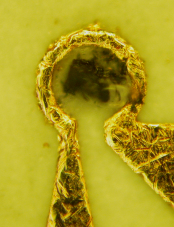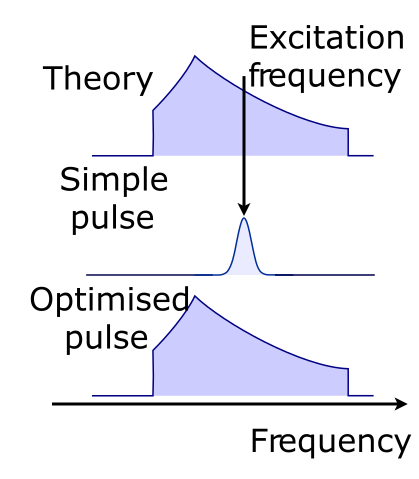Electron Spin Resonance
Microresonators for ESR
Anton Savitsky, in collaboration with Jason Sidabras, Medical College of Wisconsin, USA
EPR resonators on the basis of standing-wave cavities are optimised for large samples. For small samples it is possible to design different resonators that have much better power handling properties and higher sensitivity. Other parameters being equal, the sensitivity of the resonator can be increased by minimising its size and thus increasing the filling factor. Like in NMR, it is possible to use lumped elements; coils can confine the microwave field to volumes that are much smaller than the wavelength. Our test resonators, which operate at a frequency of 14 GHz, have excellent microwave efficiency factors, achieving 20 ns π/2 EPR pulses with an input power of <1 mW. Their efficiency is thus about six orders of magnitude higher than that of conventional resonators.
Additional details are available here and in the references at the bottom of this page.

Raman Heterodyne Detection of EPR
Detection of electron spin resonance via optical heterodyne detection brings some useful enhancements to this spectroscopic technique. In particular, the coherent Raman process provides higher selectivity than conventional detection: the dependence on the optical wavelength allows us to eliminate signal contributions from impurities, while the dependence on the polarization of the laser beam provides a possibility to determine the orientation of the g-tensor with respect to the electric dipole moment and therefore to the molecular geometry. As an example, we have measured EPR spectra of transition metal ions in Ruby and in different metalloproteins containing iron or copper ions.

Optimised excitation of broad EPR spectra
Various interactions an make EPR spectra so broad that it is difficult to excite the full bandwidth with conventional radio-frequency pulses. The microresonators mentioned above provide a very attractive possibility for efficient excitation: they have a large bandwidth and extremely high conversion efficiency of microwave power into microwave magnetic fields. We develop various schemes that realise this potential for exciting broad spectra, including shaped pulses designed by optimal control theory, fast frequency switching, and phase-modulated trains of low-power pulses. The theoretical pulse shapes can be realised experimentally with the help of a fast arbitrary waveform generator (AWG).

Relevant Publications:
[1] The design and sensitivity of microwave frequency optical heterodyne receivers
S. J. Bingham, B. Börger, D. Suter and A. J. Thomson
Rev. Sci. Instrum. 69, 3403-3409 (1998)
[2] Optically detected electron paramagnetic resonance by microwave modulated magnetic circular dichroism
B. Börger, S. J. Bingham, J. Gutschank, M. O. Schweika, D. Suter and A. J. Thomson
J. Chem. Phys. 111, 8565-8568 (1999)
[3] Probing the electronic structure of transition metal ion centres in proteins by coherent Raman-detected electron paramagnetic resonance spectroscopy
S. J. Bingham, B. Börger, J. Gutschank, D. Suter and A. J. Thomson
JBIC 5, 30-35 (2000)
[4] Magnetic circular dichroism anisotropy from coherent Raman detected electron paramagnetic resonance spectroscopy: Application to spin-1/2 transition metal ion centers in proteins
S. J. Bingham, J. Gutschank, B. Börger, D. Suter and A. J. Thomson
J. Chem. Phys. 113, 4331-4339 (2000)
[5] Deconvolution and Assignment of Different Optical Transitions of the Blue Copper Protein Azurin from Optically Detected Electron Paramagnetic Resonance Spectroscopy
B. Börger, J. Gutschank, D. Suter, A. J. Thomson and S. J. Bingham
J. Am. Chem. Soc. 123, 2334-2339 (2001)
[6] Magnetic and optical anisotropy of Clostridium pasteurianumrubredoxin from optically detected electron paramagnetic resonance
B. Börger and D. Suter
J. Chem. Phys. 115, 9821-9826 (2001)
[7] Magneto-optical and EPR transitions in Raman heterodyne spectroscopy
M. O. Schweika-Kresimon, J. Gutschank and D. Suter
Phys. Rev. A 66, 043816 (2002)
[8] Orientational Information from Unoriented Metalloproteins by Optically Detected Electron Paramagnetic Resonance
J. Gutschank, D. Suter and B. Enkisch
J. Anal. At. Spectrom. 19, 34-40 (2004)
[9] Planar microresonators for EPR experiments
R. Narkowicz, D. Suter and R. Stonies
J. Magn. Reson. 175, 275-284 (2005)
[10] Scaling of sensitivity and efficiency in planar microresonators for electron spin resonance
R. Narkowicz, D. Suter and I. Niemeyer
Rev. Sci. Instrum. 79, 084702 (2008)
[11] Visualization of spin dynamics in single nanosized magnetic elements
A. Banholzer, R. Narkowicz, C. Hassel, R. Meckenstock, S. Stienen, O. Posth, D. Suter, M. Farle and J. Lindner
Nanotechnology 22, 295713 (2011)
[12] Electron paramagnetic resonance investigation of the electron-doped manganite La1-xTexMnO3 (0.1 < x < 0.2)
J. Yang, X. Rong, D. Suter and Y. P. Sun
Phys. Chem. Chem. Phys. 13, 16343-16348 (2011)
[13] Room temperature strong coupling between a microwave oscillator and an ensemble of electron spins
G. Boero, G. Gualco, R. Lisowski, J. Anders, D. Suter and J. Brugger
J. Magn. Reson. 231, 133 - 140 (2013)
[14] Broadband excitation by chirped pulses: application to single electron spins in diamond
I. Niemeyer, J. H. Shim, J. Zhang, D. Suter, T. Taniguchi, T. Teraji, H. Abe, S. Onoda, T. Yamamoto, T. Ohshima, J. Isoya and F. Jelezko
New J. Phys. 15, 033027 (2013)
[15] A cryogenic receiver for EPR
R. Narkowicz, H. Ogata, E. Reijerse and D. Suter
J. Magn. Reson. 237, 79--84 (2013)
[16] Angular dependent ferromagnetic resonance analysis in a single micron sized cobalt stripe
C. Schoeppner, K. Wagner, S. Stienen, R. Meckenstock, M. Farle, R. Narkowicz, D. Suter and J. Lindner
Journal of Applied Physics 116, 033913 (2014)
[17] Tuner and radiation shield for planar electron paramagnetic resonance microresonators
R. Narkowicz and D. Suter
Review of Scientific Instruments 86, 024701 (2015)
[18] Extending electron paramagnetic resonance to nanoliter volume protein single crystals using a self-resonant microhelix
J. W. Sidabras, J. Duan, M. Winkler, T. Happe, R. Hussein, A. Zouni, D. Suter, A. Schnegg, W. Lubitz and E. J. Reijerse
Science Advances 5, (2019)
[19] Magnetization Dynamics of an Individual Single-Crystalline Fe-Filled Carbon Nanotube
K. Lenz, R. Narkowicz, K. Wagner, C. F. Reiche, J. Körner, T. Schneider, A. K\'akay, H. Schultheiss, U. Weissker, D. Wolf, D. Suter, B. Büchner, J. Fassbender, T. Mühl and J. Lindner
Small 2019, 1904315 (2019)

